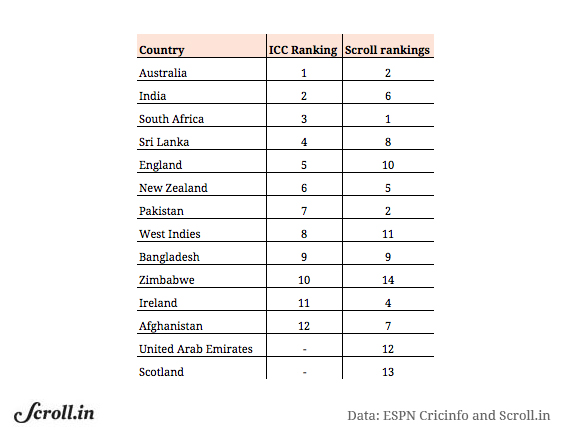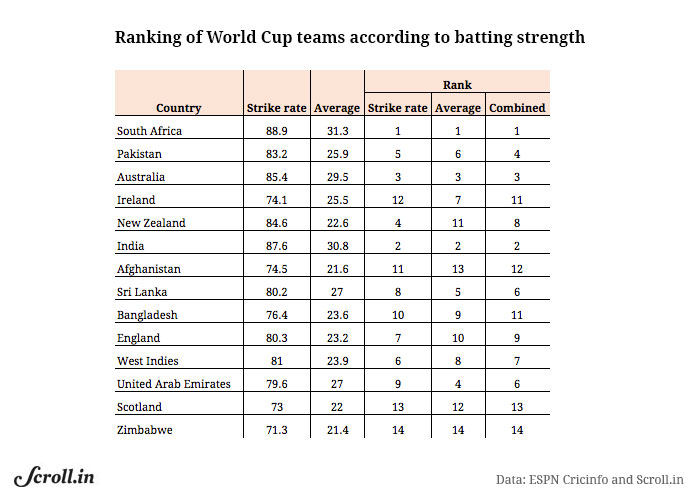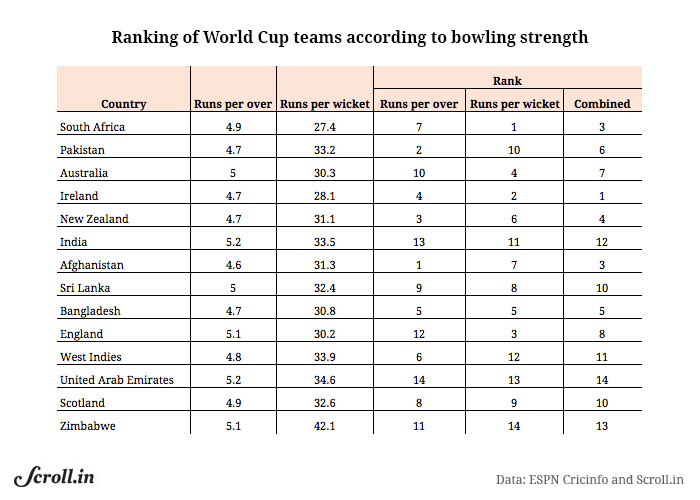The countdown has begun. In less than four weeks 14 teams will participate in the cricketing extravaganza that is the World Cup. Among them will be some favourites and some minnows, each vying to seize that 2-foot high gold and silver trophy at the end of the 44-day tournament.
Looking to retain possession of that trophy will be India, the winners of the World Cup’s 2011 edition. Of the 15-member squad chosen for the tourney, only four – M S Dhoni, Virat Kohli, Suresh Raina and Ravichandran Ashwin – have played in an earlier edition. The remaining Men in Blue are relatively green.
The 2015 World Cup is unique for a handful of reasons. It is the first time Afghanistan is participating in the jamboree. It could also be the last time that the associate teams – Ireland, Afghanistan, Scotland and United Arab Emirates – get to infuse their enthusiasm into the World Cup since the International Cricket Council, the governing body of cricket, has decided to cut down the number of participating teams to 10 in 2019.
If official rankings alone are an indicator, India may stand a good chance. In the one-day rankings of the International Cricket Council, Australia and India are tied at number one spot, with 117 points each. Right behind them, at number 3, is South Africa with 112 points.
Of the top eight teams in the ICC rankings, only three – England, South Africa and New Zealand – have never won a World Cup before. England have come the closest of these by reaching three finals. New Zealand and South Africa have only managed to make it to the semi-finals before.
This time, however, could be very different.
Scroll.in analysed and aggregated the career one-day international figures of the 15 players selected by each team for the World Cup. For the batting parameter, the strike rate and batting average were looked at. For the bowling, the economy rate and runs conceded per wicket were aggregated. And for the fielding, the unconventional statistic of the average number of catches per innings was considered.
In these rankings, South Africa emerged at the top. In fact, South Africa were number one on all parameters, whether batting, bowling or fielding.
The team is going into the tournament with a strong batting and bowling line-up. In contrast to India, they have eight players with previous World Cup experience – AB de Villiers (captain), Hashim Amla (vice-captain), Faf du Plessis, JP Duminy, Wayne Parnell, Morne Morkel, Dale Steyn and Imran Tahir.
Batting
In Scroll’s rankings, only two teams show a 30-plus batting average: India (30.8) and South Africa (31.2). South Africa’s average strike rate of 88.9 is the best: for every 100 balls, they score a shade under 90 runs.
In 2014, South Africa enjoyed a successful run, winning all but one tournament (the 1-4 series loss to Australia in November). Their top order is strong, comprising Amla, de Villiers, de Kock and du Plessis. All of them are accomplished players in the one-day format, with Amla and de Villiers proving to be one of the most successful pairs in the country’s cricketing history.
Bowling
As Scroll’s below rankings show, South Africa may give away more runs than some other teams on average, but they concede the least runs per wicket. At an average of 27.4 runs per wicket, they are the only team other than Ireland to give less than 30 runs per wicket. The squad’s 15 selected members have together taken 504 wickets.
In Daley Steyn, Morne Morkel and Vernon Philander, South Africa have an effective pace attack that can use to its advantage the bouncy pitches and conditions of Australia and New Zealand. They may not have a specialist spinner, but the conditions do not demand one. If at all the need arises, Imran Tahir can more than plug the gap.
Fielding
Even in the fielding department (catches), South Africa come at top position. They take an average of 0.5 catches per innings fielded. Somewhat surprisingly, India have taken nearly the same average number of catches per innings – 0.48.
Looking to retain possession of that trophy will be India, the winners of the World Cup’s 2011 edition. Of the 15-member squad chosen for the tourney, only four – M S Dhoni, Virat Kohli, Suresh Raina and Ravichandran Ashwin – have played in an earlier edition. The remaining Men in Blue are relatively green.
The 2015 World Cup is unique for a handful of reasons. It is the first time Afghanistan is participating in the jamboree. It could also be the last time that the associate teams – Ireland, Afghanistan, Scotland and United Arab Emirates – get to infuse their enthusiasm into the World Cup since the International Cricket Council, the governing body of cricket, has decided to cut down the number of participating teams to 10 in 2019.
If official rankings alone are an indicator, India may stand a good chance. In the one-day rankings of the International Cricket Council, Australia and India are tied at number one spot, with 117 points each. Right behind them, at number 3, is South Africa with 112 points.
Of the top eight teams in the ICC rankings, only three – England, South Africa and New Zealand – have never won a World Cup before. England have come the closest of these by reaching three finals. New Zealand and South Africa have only managed to make it to the semi-finals before.
This time, however, could be very different.
Scroll.in analysed and aggregated the career one-day international figures of the 15 players selected by each team for the World Cup. For the batting parameter, the strike rate and batting average were looked at. For the bowling, the economy rate and runs conceded per wicket were aggregated. And for the fielding, the unconventional statistic of the average number of catches per innings was considered.
ICC One-Day rankings versus Scroll rankings
In these rankings, South Africa emerged at the top. In fact, South Africa were number one on all parameters, whether batting, bowling or fielding.
The team is going into the tournament with a strong batting and bowling line-up. In contrast to India, they have eight players with previous World Cup experience – AB de Villiers (captain), Hashim Amla (vice-captain), Faf du Plessis, JP Duminy, Wayne Parnell, Morne Morkel, Dale Steyn and Imran Tahir.
Batting
In Scroll’s rankings, only two teams show a 30-plus batting average: India (30.8) and South Africa (31.2). South Africa’s average strike rate of 88.9 is the best: for every 100 balls, they score a shade under 90 runs.

In 2014, South Africa enjoyed a successful run, winning all but one tournament (the 1-4 series loss to Australia in November). Their top order is strong, comprising Amla, de Villiers, de Kock and du Plessis. All of them are accomplished players in the one-day format, with Amla and de Villiers proving to be one of the most successful pairs in the country’s cricketing history.
Bowling
As Scroll’s below rankings show, South Africa may give away more runs than some other teams on average, but they concede the least runs per wicket. At an average of 27.4 runs per wicket, they are the only team other than Ireland to give less than 30 runs per wicket. The squad’s 15 selected members have together taken 504 wickets.

In Daley Steyn, Morne Morkel and Vernon Philander, South Africa have an effective pace attack that can use to its advantage the bouncy pitches and conditions of Australia and New Zealand. They may not have a specialist spinner, but the conditions do not demand one. If at all the need arises, Imran Tahir can more than plug the gap.
Fielding
Even in the fielding department (catches), South Africa come at top position. They take an average of 0.5 catches per innings fielded. Somewhat surprisingly, India have taken nearly the same average number of catches per innings – 0.48.
Limited-time offer: Big stories, small price. Keep independent media alive. Become a Scroll member today!
Our journalism is for everyone. But you can get special privileges by buying an annual Scroll Membership. Sign up today!